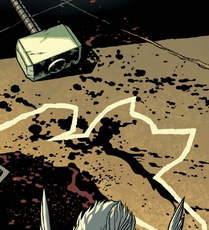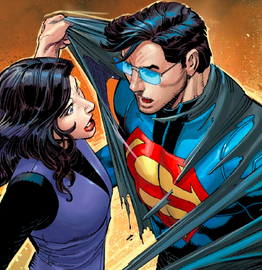Deadshirt Is Reading… is a weekly feature in which Deadshirt’s staff, contributing writers, and friends-of-the-site offer their thoughts on Big Two cape titles, creator-owned books, webcomics and more. For more of our thoughts on this week’s new comics, take a look at Wednesday’s Deadshirt Comics Shopping List.
Joe Stando is reading…
Written by Jason Aaron
Art by Chris Sprouse & Gordon Sudzuka (pencils) and Karl Story & Dexter Vines (inks)
Colored by Marte Gracia
Lettered by Joe Sabino
Marvel
“You’re kidding, right? This is Battleworld. People disappear all the time.”
Thors is one of the funniest, best executed concepts in an event that favors funny, well-executed concepts. The use of non-stop police procedural tropes deftly parodies both the tropes themselves and the core status quo of Battleworld. It’s a great hook, which is why I was a little disappointed I didn’t like this issue more.
Issue 2 picks up at the funeral of Beta Ray Bill, and follows it with the various Thors working on his murder, shaking down “the usual suspects,” who are mostly Hulks, Ultron robots and the like. A Thor pummeling Ultron in the stomach while yelling “talk, robot!” is the stuff dreams are made of, but outside of that sequence, there’s not quite as much to like here as in the first issue. A lot of that boils down to the fact that without Bill around, Thorlief has to spend a lot of time doing interior monologues, and they’re not quite as pitch perfect as the cop banter we’ve seen. The art also doesn’t pop quite as much, although most of that is intentional, with Gracia’s dull and dark colors mirroring a noir story.
That’s not to say I didn’t love the parts of this issue that clicked. The old captain Thor’s eulogy of Bill is great, as it runs through his career with beats like “Berserker” and “the Hall of Vice.” Thrr, the dog-man Thor, is both a cool looking design and a pretty clever inversion of Throg. And the continued presence of current era 616 Odinson as “Thor the Unworthy” is interesting, even if I wish he’d get out of the way so we could get some more of (Battleworld’s version of) the new Thor.
A friend of mine wasn’t thrilled by Thors because he felt the premise was too thin to be sustainable. I have a feeling it’s building to something pretty big at the end of the run, but this issue dragged a little bit. The Law & Order: Battleworld take is evergreen, though, and even after the event, I’d love to see these kinds of stories in a “Tales of Battleworld” style anthology.
Patrick Stinson is reading…
Written by Jason Aaron
Art by Simone Bianchi
Colored by Justin Ponsor
Lettered by Chris Eliopaulos
Marvel
“You never trained me for this, Master Qui-Gon. You never trained me how to fade away.”
This is a cool issue with a cool gimmick. It’s presented “from the journal of Ben Kenobi” and is a one-off flashback adventure on Tatooine, when Luke is maybe seven years old. The idea of an old ronin struggling to lie low and ignore injustice where once he tackled it head-on is not exactly revolutionary—for Marvel, comics, Star Wars, or human fiction in general. But here the story is tackled with style and restraint.
The art team emphasizes color—the unbearable warms of the day and the ominous, mystical cools of the night—and their lines are curiously uneven and frayed, signifying the deteriorating mentality of Ben and the farmers. For you see, apparently Tatooine experiences droughts where even the moisture farmers struggle to bring water out of the air as usual, and Jabba the Hutt has decided to make matters worse by sending thugs around to round up all the water he can. Seems a little harsh considering he could just fly it in with all his other luxuries, but a good ronin story needs bandits.
(Two minor fan quibbles—Ben still looks exactly like Ewan McGregor even after many years have passed on Tatooine, and Owen and Beru are portrayed so positively that later-Luke’s total disinterest in them (see my previous New Marvel Star Wars reviews) seems more egregious than ever. Look, it wouldn’t be a proper Star Wars review without quibbles.)
What could have been a depressingly typical story is elevated by two things. The first is restraint—the creative team avoids having a glowing Liam Neeson show up, and a lightsaber is never ignited in anger. In fact, the way Ben deals with matters very much plays into his later reputation as a “wizard,” though the connection is not explicit. The second is its treatment of Luke. His appearance is brief but intensely memorable, cutting through the fogginess of Ben’s and the reader’s perceptions. Seeing Luke before his whiny teen phase emphasizes that his selflessness and righteousness are much more fundamental to the character. In this issue Ben never teaches Luke, Luke teaches Ben.
Jason Urbanciz is reading…
Written by Gene Luen Yang
Art by John Romita, Jr. (pencils) and Klaus Janson (inks)
Colored by Dean White, Wil Quintana and Tomeu Morey
Lettered by Rob Leigh
DC Comics
“So Jimmy gets the truth and I get the lie.”
Someone knows Clark Kent’s secret and is threatening to reveal it to the world unless he silences a whistleblower. Of course, since he’s Superman, he does the right thing and saves her, and goes on the run along with Jimmy Olsen and Lois Lane. In doing so, he’s forced to cop to being Superman after Lois confronts him, which doesn’t exactly go over well (see this review’s pullquote above). Pushing their problems aside to deal with the threat of HORDR—which is basically Evil Google that is using people’s secrets to do…something evil—the team sets out to confront them by sneaking onto their campus (which of course has flying latte bars) and starting some shit.
We’re two issues into his run, and Gene Yang’s Superman is turning out to be a blast. As Max pointed out on Twitter, it seems really reminiscent of Jack Kirby’s work when he first came on Superman’s Pal Jimmy Olsen, dealing with high tech villains and the rise of new media when it comes to news and people’s secrets. Of course, John Romita Jr.’s work on art definitely helps play up the Kirby similarities. Romita’s big blocky figures and very unique-looking tech invest the art with a raw dynamism that makes the images pop from the page/screen. While Kirby worked in a very tight six panel grid, Romita uses a looser eight panel style that generally allows the panels to open up and be more cinematic in places or shrink down to focus in on smaller actions.
While there is a fair bit of controversy about the current Super-books’ decision to have Lois out Clark as Superman in the press, this book really nails the emotional honesty of both characters. We see this especially in a sequence where Clark tries to explain to Lois why he hid himself from her, with Lois putting aside her hurt feelings to deal with the more pressing situation at hand. Yang and Romita definitely have more twists and turns coming in this story, and it’s almost a guarantee that this situation is going to deepen as it races to its conclusion.
That’s what we’re reading this week! What comics did you pick up? Leave us a comment below, or hit us up on Facebook or Twitter!




